
Japanese manga
Manga (漫画) are funny books or realistic books beginning from Japan. Most manga adjusts to a style created in Japan in the late nineteenth century, however, the artistic expression has a long ancient time in prior Japanese workmanship. The term manga is utilized in Japan to allude to the two funnies and cartooning. Outside Japan, the word 늑대닷컴 is commonly used to allude to funnies initially distributed in the country.
Dōjinshi
Dōjinshi (同人誌, fan magazine), fan-made Japanese funnies, work in a far bigger market in Japan than the American “underground funnies” market; the biggest dōjinshi reasonable, Comiket, draws in 500,000 guests two times every year.
/pic5782610.png)
Korean manhwa
Korean manhwa has rapidly acquired ubiquity outside Korea lately because of the Korean Wave. The manhwa business has endured two accidents and severe restrictions since its initial beginnings because of the Japanese control of the promontory which stunts the development of the business however has now begun to thrive thanks to a limited extent to the web and better approaches to peruse manhwa whether on PCs or through cell phones. In the past manhwa would be exhibited as manga outside the country to guarantee they would sell well anyway as of now that isn’t for the most part needed since more people are as of now more taught with respect to the business and Korean culture.
Webtoons
Webtoons have become famous in South Korea as a better approach to understanding funnies. Much appreciated to some extent to various oversight rules, shading and interesting enhanced visualizations, and streamlining for more straightforward perusing on cell phones and PCs. More manhwa has changed from customary print manhwa to online webtoons on account of preferred compensation and more opportunity over conventional print manhwa. The webtoon design has additionally extended to different nations outside of Korea like China, Japan, Southeast Asia, and Western nations. Major webtoon wholesalers incorporate Lezhin, Naver, and Kakao.
Franco-Belgian comics
- France and Belgium have a long practice in funnies and comic books called BDs (a shortening of bande dessinées) in French and strips in Dutch. Belgian comic books initially written in Dutch show the impact of the Francophone “Franco-Belgian” funnies yet have their own particular style. The name bande dessinée gets from the first depiction of the work of art as drawn strips (the expression in a real sense interprets as “the drawn strip”), comparable to the succession of pictures in a film strip. As in its English same, “bande” can be applied to both film and funnies.
- Fundamentally, the French-language term contains no sign of topic, in contrast to the American expressions “funnies” and “funnies”, which suggest a work of art not to be viewed in a serious way. The differentiation of funnies as le neuvième workmanship (in a real sense, “the 10th craftsmanship”) is predominant in French grant on the structure, just like the idea of funnies analysis and grant itself.
- Comparative with the separate size of their populaces, the multitudinous writers in France and Belgium distribute a high volume of comic books. In North America, the more genuine Franco-Belgian funnies are regularly considered to be identical to realistic books, yet regardless of whether they are long or short, bound or in magazine design, in Europe, there is no requirement for a more modern term, as the craftsmanship’s name doesn’t itself suggest something negligible.



